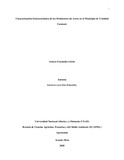Please use this identifier to cite or link to this item:
https://repository.unad.edu.co/handle/10596/34791Full metadata record
| DC Field | Value | Language |
|---|---|---|
| dc.contributor.advisor | Díaz Bobadilla, Adriana Lucia | - |
| dc.coverage.spatial | cead_-_acacias | spa |
| dc.creator | Fernández Girón, Arturo | - |
| dc.date.accessioned | 2020-06-11T02:53:33Z | - |
| dc.date.available | 2020-06-11T02:53:33Z | - |
| dc.date.created | 2020-06-03 | - |
| dc.identifier.uri | https://repository.unad.edu.co/handle/10596/34791 | - |
| dc.description.abstract | El presente trabajo se desarrolló en el municipio de Trinidad departamento de Casanare, con el objetivo de conocer la situación socioeconómica de los agricultores del cultivo de arroz en el año 2018, se evaluaron dos clases de productores los que participaron de esta actividad en sus propias fincas, es decir con terrenos propios y los agricultores que sembraron en terrenos en arriendo. Se realizó un análisis de los costos de producción empleado en los dos tipos de productores en el cultivo de arroz, los que participaron en terrenos propios y los que lo hicieron en terrenos en arriendo. El sector arrocero es el más importante de las actividades agrícolas que se realiza en el municipio, ha jalonado de manera positiva la economía agrícola en esta región. El resultado de este trabajo determino aspectos como número de productores (hombres) en terrenos propio y en arriendo, también es importante destacar la participación que tuvieron las mujeres como productoras de este cultivo, la mayoría de ellas lo hicieron en terreno en arriendo, los costos de producción por hectárea de los en los dos tipos de productores, sistema de producción empleado por los agricultores. Las fincas que participaron de esta actividad agrícola en el año 2018 fue de 108 predios, distribuidos en 21 veredas con un área sembrada de 17.471 hectáreas de arroz. Este municipio ocupo a nivel nacional el cuarto puesto en área sembrada en el cultivo de arroz secano mecanizado, solo superado por los municipios de Paz de Ariporo con un área de 22.861 hectáreas, San Luis de Palenque con un área de 21.021 hectáreas y Macon un área de 19.896 hectáreas. (Dane-Fedearroz, 2018). Trinidad tiene una extensión total de 294.700 hectáreas, donde el sector arrocero utilizo el 5,92% del territorio, es decir 17.471 hectáreas sembradas. | spa |
| dc.format | ||
| dc.title | Caracterización socioeconómica de los productores de arroz en el municipio de Trinidad Casanare. | |
| dc.type | Proyecto aplicado | |
| dc.subject.keywords | Producción, Cultivo de arroz,Suelo. | spa |
| dc.description.abstractenglish | The present work was carried out in the municipality of Trinidad, department of Casanare, with the objective of knowing the socioeconomic situation of the farmers of rice cultivation in 2018, two classes of producers who participated in this activity in their own farms were evaluated. That is to say, with their own land and the farmers who planted it in land for rent. An analysis of the production costs used in the two types of producers in rice cultivation was carried out, those who participated in their own land and those who participated in land for rent. The rice sector is the most important of the agricultural activities carried out in the municipality, it has positively marked the agricultural economy in this region. The result of this work determined aspects such as number of producers (men) on their own land and for rent, it is also important to highlight the participation that women had as producers of this crop, most of them did it on land for rent, the costs of production per hectare of the two types of producers, production system used by farmers. The farms that participated in this agricultural activity in 2018 were 108 farms, distributed in 21 sidewalks with a planted area of 17,471 hectares of rice. At the national level, this municipality ranked fourth in the area sown in mechanized dryland rice cultivation, second only to the municipalities of Paz de Ariporo with an area of 22,861 hectares, San Luis de Palenque with an area of 21,021 hectares and Mani with a area of 19,896 hectares. (Dane-Fedearroz, 2018). Trinidad has a total extension of 294,700 hectares, where the rice sector used 5.92% of the territory, that is to say 17,471 hectares planted. | spa |
| dc.subject.category | Agronomía | spa |
| Appears in Collections: | Agronomía | |
Files in This Item:
| File | Description | Size | Format | |
|---|---|---|---|---|
| afernandezgi.pdf | 2.49 MB | Adobe PDF |  View/Open |
Items in DSpace are protected by copyright, with all rights reserved, unless otherwise indicated.
